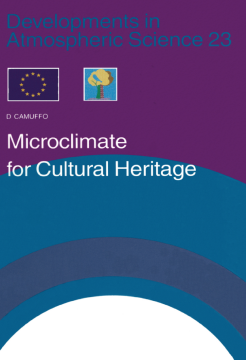
Additional Information
Book Details
Abstract
This is a useful microphysics handbook for conservators and specialists in physics, chemistry, architecture, engineering, geology and biology dealing with the environment and works of art. A rigourous treatment and a background familiarity with the underlying physics behind mathematics are covered, giving a detailed description and interpretation of the main microphysical phenomena, removing unsound popular beliefs. The basis are given for non-destructive diagnostics to evaluate causes of damage determined by atmoshpheric factors, as well as negative consequences of the unsound use of technology and mass tourism. To this aim, suggestions are given on the fundamental principles in designing heating, air conditioning, lighting and in reducing the deposition of pollutants on works of art. Theory and experience are coupled to describe the complex condensation mechanisms and the fundamental role played by water in the stone deterioration and the formation of crusts on monuments. Urban meteorology, air-surface interactions, atmospheric stability, dispersion and deposition of airborne pollutants are also key topics of this book, for which the main aim has been to make comprehensible to a wider audience a matter that is only familiar to a few specialists.
This book combines a theoretical background with many years of accurate laboratory research, field surveys and practice. The first part, devoted to applied theory, is a concise treatise on microphysics, which includes a survey on the basic ideas which are necessary for environmental diagnostic and conservation. The second part of the book focuses on the practical utilisation and shows in detail how field surveys should be performed, with many suggestions and examples and the indication of some common errors that should be avoided.
A. Longhetto
...highly recommended book.
Il Nuovo Cimento Vol. 22, no. 1
N.S. Baer, Hagop Kevorkian Professor of Conservation, Institute of Fine Arts
Even the most casual reader of the conservation literature will have encountered examples of the remarkable body of work by Dario Camuffo wherein he has applied fundamental principles of physics to the study of the microenvironment of such diverse systems as temperature and humidity gradients in the Sistine Chapel, acid deposition and biocorrosion on Trajan's column, and the aeolian erosion of the Great Sphinx.
The present work is no mere compilation or recapitulation of the author's previously published papers, but rather a publication of the fundamental principles and theoretical basis for the study of the microenvironments encountered by the most diverse forms of cultural property. It is appropriate that it finds its place in the series, 'Developments in Atmospheric Science' among such titles as Physical Principles of Micro-Meteorological Measurements, Man's Impact on Climate and Atmospheric Aerosols. Where rigor is called for, the treatment includes derivations and equations. Yet the author never allows rigor mortis to set in. Always, clear practical examples are provided. Indeed, the theoretical treatment is at the service of the discussions of the many case studies introduced.
It is perhaps useful to consider Camuffo's text in parallel to the widely read classic by Garry Thomson, The Museum Environment. In attempting to deal with the different levels of scientific appreciation brought by his prospective readers, Thomson covers the same material twice, offering, in effect, an introductory version and then a more advanced version for each topic. This solution always seemed rather artificial. It is much to the credit of Dr. Camuffo that he has written a book that may be the advanced-level version of The Museum Environment, while integrating the treatment in such a way that the conservator, the conservation scientist and the atmospheric physicist can all turn to it for reference and even enjoyment.
The book is divided into two parts, 'Atmospheric physics applied to microclimate analysis and conservation' and 'Performing microclimate field surveys'. The first part, which forms approximately three-quarters of the text, covers microclimate, air and temperature; humidity, the description of air masses and vertical motions; radiation and light; the physics of drop formation and micropore condensation: atmospheric water and stone weathering; atmospheric stability and pollutant dispersion; and dry deposition of airborne particulate matter. The second part deals with practical aspects of field measurement and survey for parameters associated with temperature, humidity, wind, indoor air motion, rainfall and windborne droplets.
A great number of diagrams and photographs with clear explanatory captions support the exposition. The generous inclusion of a few color plates is a pleasant extravagance.
In sum, Dario Camuffo has provided a definitive treatment of a central aspect of conservation science and a most useful introduction to the application of atmospheric physics to the preservation of cultural property. The practising conservator, especially one who looks askance at the differential equations that not infrequently grace the pages of this journal, would also benefit from an acquaintance with this book. In that regard, it is a pity that the otherwise most thorough subject index does not include the names of the many monuments that form the case studies and practical examples discussed.
Studies in Conservation 45
B.D. Amiro
...the potential for this book could be substantial in many senior undergraduate courses.
Agricultural and Forest Meteorology
